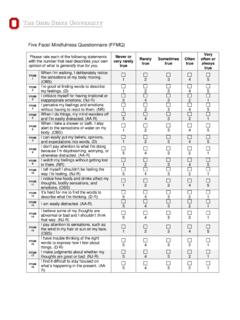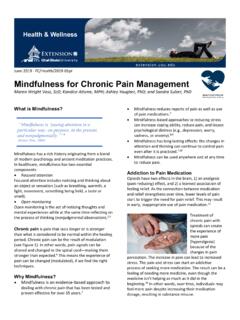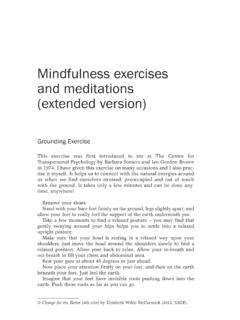Transcription of Family Tool Kit - Mindfulness Everyday
1 Mindful Parenting Family tool Kit Mindfulness Everyday 20 Guildwood Parkway PH3 Scarborough, ON M1E 5B6 (416) 267-4707 More Information HERE Mindfulness for Families Page 2 Compiled by Mindfulness Everyday Mindful Parenting - Skill for being with the Ups and Downs of Life Curriculum Authors Susan Hutton Heidi Bornstein Managing Editor Heidi Bornstein Design & Production Heidi Bornstein September 2015 All content is protected by copyright Mindfulness Everyday Redistribution, replication or commercial use is prohibited without expressed written permission of Mindfulness Everyday who is the sole owner and copyright holder of this property. For more information on educational programs and materials, please contact us at Mindful Parenting provides Stress Reduction & Life Strategies for parents, based on the principles of the MBSR ( Mindfulness -Based Stress Reduction) Workshop program created by Jon Kabat-Zinn at the University of Massachusetts Medical Centre in 1979.
2 Mindfulness Everyday is a registered Canadian charity #83693 3507 RR0001. Mindfulness for Families Page 3 Compiled by Mindfulness Everyday MINDFUL Family tool KIT MINDFUL Family tool KIT .. 3 WHAT IS Mindfulness ? .. 4 Definitions of Mindfulness .. 4 Mindfulness for Families .. 5 5 MINDFUL PARENTING SELF CARE TIPS .. 5 1. Mindfulness BOX .. 6 2. Mindfulness BELL .. 6 3. Family MINDFUL ART .. 6 4. GRATITUDE ACTIVITY .. 7 5. BLOWING BUBBLES BREATHING .. 7 6. INFINITY SYMBOL BREATHING .. 7 7. COUNTING OCEAN BREATHS FOR SLEEP .. 8 8. BREATHING BUDDIES .. 8 9. FIVE FINGER BREATHING .. 8 10. STONE BREATH .. 8 11. MINDFUL EATING .. 9 12. MINDFUL WALKING ACTIVITY .. 10 13. MANAGING TEST ANXIETY .. 11 14. SUGGESTED Mindfulness PARENTING ONLINE RESOURCES .. 12 Mindfulness for Families Page 4 Compiled by Mindfulness Everyday WHAT IS Mindfulness ?
3 Definitions of Mindfulness Mindfulness is the awareness that arises from paying attention in a particular way, on purpose, to the present moment, with non-judgment. Jon Kabat-Zinn Mindfulness is paying attention to the here and now, with kindness and curiosity. Amy Saltzman, Mindfulness for Families Page 5 Compiled by Mindfulness Everyday Mindfulness for Families Mindfulness can be fun! Here you will find inclusive ways to bring Mindfulness practice to your Family life. This is a tool kit if you will, of all ages Mindfulness practices. Please adapt and make them your own, in a way that suits your Family . Bring Mindfulness to all of your life with your children. Remembering the key is to take your oxygen before embarking on anything. Simply pay attention to your breath and your body and add Mindfulness before reacting.
4 5 MINDFUL PARENTING SELF CARE TIPS 1. Be Present (Are you thinking about the past or worrying about the future? What is happening RIGHT HERE RIGHT NOW) 2. Practice Compassion (For yourself, children and others) 3. Beware of Thought (Thoughts are not always Facts) 4. Acknowledge what you are feeling - emotions (Name it to Tame it) 5. Be Aware of Breath (Vagus Nerve - Deep Breath relaxes the body) 6. Be Aware of Body (Body Scan: Befriend Gravity) 7. Accept Things as They Are (Respond vs React it is what it is) 8. Be Mindful of Technology (Turn it off, all of it, sometimes) 9. Acknowledge Transitions - Transitions are the spaces between moments. Transitions are not just about just getting you ready for the next experience, they are the experience. Mindfulness for Families Page 6 Compiled by Mindfulness Everyday 1.
5 Mindfulness BOX Create a little chest or box at home that your son or daughter can keep Mindfulness reminders. It can be a safe space they go when they are feeling upset. A Mindfulness chest can hold things like: Papers with instructions on Figure 8 and hand practices Stones or pebbles they have gathered to practice with A little bell they ring to remind them of listening A jar of sparkles and water Mindfulness Art work Mindfulness booklet 2. Mindfulness BELL Find a place in your home to have a bell that is available for anyone to ring. When it is rung, everyone in the home pauses for 3 breaths. Stop whatever you are doing, and just feel the breath in your body. Allow the body to relax and just feel the sensations in the present moment. It takes a while to get everyone into the flow of the Mindful Bell, so be patient.
6 Just having the bell in the hallway or in a corner of a room can be a reminder for the Family to be more mindful. 3. FA M I LY MINDFUL ART Take some time to do art with your son or daughter. You can play some relaxing music while you do so, and feel the breath in your body as you close your eyes and draw lines together; breathing in draw one line, and on the outbreath draw in another direction. Colour them in and you can discuss what you find when you look at the art. Hang it on the wall as a beautiful reminder of your breathing. Mindfulness for Families Page 7 Compiled by Mindfulness Everyday 4. GRATITUDE ACTIVITY A nice easy activity you can do at meal time, before bed, or whenever you like. Research shows that practicing the 3 E s of Gratitude get results and help people improve wellbeing.
7 Children can keep listing things and people they are grateful for. It doesn t have to just be one. Encourage them to feel how it feels to be grateful where in the body do they feel it. 1. Exercise Gratitude: Do it Everyday , just like physical exercise 2. Emote Gratitude: Mindfully feel the emotions ( sensations associated with gratitude) 3. Express Gratitude: Tell it to people in your life, like your Family 5. BLOWING BUBBLES BREATHING Have some fun and get out the bubbles. This is a great way to help younger kids (and adults) get in touch with the feeling of the outbreath. Breathe in deeply and feel your sensations as you breathe out fully while you blow bubbles. 6. INFINITY SYMBOL BREATHING Trace your finger along the inside of this infinity symbol. Starting with your finger in the centre, take a slow breath in as you move along one side of the symbol, and when you cross over to the other side, allow your breath to gently exhale.
8 Follow this breathing pattern while you trace the symbol as many times as you like. (Mind Up Curriculum, 2014). You can also practice Infinity symbol breathing by holding your finger in front of you, and tracing an infinity symbol with your finger in the air. Mindfulness for Families Page 8 Compiled by Mindfulness Everyday 7. COUNTING OCEAN BREATHS FOR SLEEP Some people count sheep to help concentrate the mind, relax the body and fall asleep. Try counting your breaths to help fall asleep. Start at one, and each time you lose track, just start over at one again. Allow each breath to feel full like the ocean tide coming and going naturally. 8. BREATHING BUDDIES For young children, an instruction to simply pay attention to the breath can be hard to follow. A breathing buddy exercise can be more accessible: Each student grabs a stuffed animal, and then lies down on their back with their buddy on their belly.
9 They focus their attention on the rise and fall of the stuffed animal as they breathe in and out. 9. FIVE FINGER BREATHING Breathe in slowly and fully tracing up your finger, and out as you trace down the other side beginning with your thumb and continuing with each of your other fingers. As you follow the outline of your hand you will feel your body calming. 10. STONE B R E AT H Collect some small to medium sized stones for practice with. Lie on your back and place the stone on your belly. Allow yourself to feel the stone rising and falling on your belly, just like a little boat in the ocean gently rises and falls with the movement of the ocean. Mindfulness for Families Page 9 Compiled by Mindfulness Everyday 11. MINDFUL EATING Mindfulness for Families Page 10 Compiled by Mindfulness Everyday 12.
10 MINDFUL WALKING ACTIVITY Walking meditation is a grounding and steadying Mindfulness activity that gives your child access to something that she can do anytime and anyplace when she needs to tune in to her own body and mind. It is a simple but supportive practice. The repetitive movement is soothing, and for many children the movement helps to quiet their minds. This is best done without shoes on. Standing like a mountain, tall and strong, with your feet hip-width apart, grounded, with your feet making contact with the earth and your head elevated to the sky. Beginning the practice by taking 3 long, slow breaths. Noticing how your feet feel making contact with the ground. Moving your weight around a little to see how it feels. Leaning forward and backward, then from side to side. Then finding your center the place where you are balanced and most strong.






